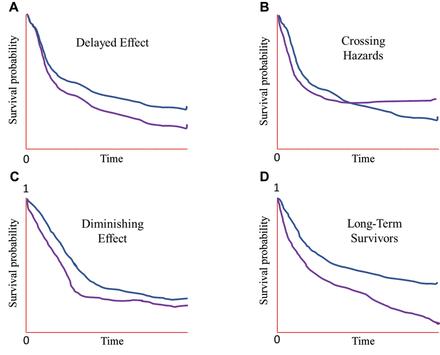
May 22, 2024
The authors have presented a review of current survival methods and contemporary methods that could help handle some of the issues that arise with current methods. The authors then went through description of current methods. They discussed censoring and while they bring some issues like non-informative censoring and truncation and even missing data, they don’t offer any solutions. The authors then brought up an overview of survival functions, hazard functions, Kaplan-Meier estimator for survival and also comparing these curves. In their discussion of the log-rank test, they failed to mention it also requires an assumption of proportionality of hazard curves and even went so far as to say that there are no specific criteria to be satisfied for the correct application of the LR test but then later on do define an instance breakdowns with proportionality so the test cannot be used.
The authors then go into an extended description of the Cox proportional hazard regression and the issues around proportionality. They described a number of potential causes of violation of this assumption. They then extended to a non-proportional hazard (NPH) regression model that incorporates a time-varying covariate and/or a stratified Cox regression model. However, these are typical proposed ways to deal with non-proportionality which works with one offender. They also then mentioned an extended Cox regression model that incorporates several timevarying predictors.
The Yang-Prentice model was shown and they said it allows for Cox modeling and NPH. The model has worked well for NPH issues like crossing curves but does not well handle
dichotomous covariates. They then discussed other models: the cure rate model, mixture model, and conditional survival model, all of which still use versions of the Cox model or other parametric models. Also, they discussed alternative methods for when the PH assumption and need to test a treatment effect like the weighted LR tests, restricted mean survival time (RMST), and Max-Combo test. They did discuss the RMST in the most detail as this has been a more novel technique for avoiding typical Cox assumptions and parametric assumptions. Finally, they did discuss the old techniques of using parametric survival distributions for modeling, but of course, one has to have a good idea of how well their data fits one of these distributional patterns. Also, they discussed landmarking analysis as an alternative approach for timedependent covariates as well as competing risks, which is really more about competing events in survival analysis. The very last modeling they discussed were frailty models as they are timevarying random effect models where the random effect has a multiplicative effect on risk and can incorporate heterogeneity amongst individuals. They concluded with that each technique should be weighed accordingly for proper use to lead to correct application and interpretation of results.
Written by, Usha Govindarajulu, PhDKeywords: survival analysis, Cox models, non-proportional hazards, log-rank test, frailty model, RMST, Max-Combo test
References
Beis G, Iliopoulos A, and Papasotiriou I (2024) “An Overview of Introductory and Advanced Survival Analysis Methods in Clinical Applications: Where Have we Come so far?” Anticancer Research: 44(2): 471-487. DOI: 10.21873/anticanres.16835
https://ar.iiarjournals.org/content/anticanres/44/2/471/F5.large.jpg? width=800&height=600&carousel=1
